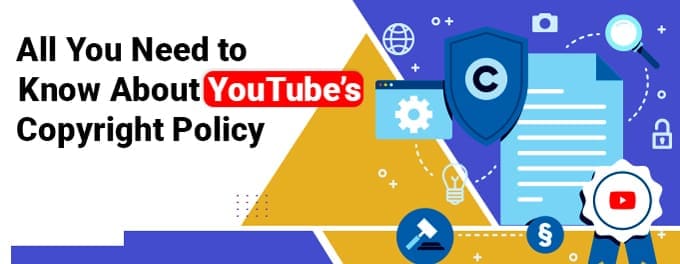17 tips to apply YouTube copyright rules [2026] 💥

Understanding and navigating YouTube copyright rules is essential for content creators looking to stay compliant and avoid disputes. A nuanced approach that combines legal compliance, creative freedom, and effective monetization is key. In this comprehensive guide, explore 17 actionable tips to maneuver through YouTube’s copyright landscape, safeguarding your content and channel.
Advertisement
1. Understanding Copyright Basics
Go to YouTube report a problem if you're unsure about how copyrights work on the platform. At its core, copyright is a law that gives the owner of original work exclusive rights to its use and distribution, usually for a limited time, with the intention of enabling the creator to receive compensation for their investment in creativity.
2. Utilize YouTube’s Copyright Center
YouTube provides a plethora of information and tools to assist content creators in understanding and navigating the copyright landscape. This can be found in the YouTube User Guide. It’s an essential resource to get acquainted with the basics of copyright, report violations or resolve disputes.
3. Apply YouTube’s Standard License
By default, content uploaded to YouTube is protected under a Standard YouTube License. This license essentially gives YouTube the permission to host the video on their platform, while the content creator retains the copyright to their work, meaning it cannot be copied or redistributed without the creator’s permission.
4. Know the Fair Use Doctrine
"Knowledge is power."
One of the foundational elements of YouTube copyright rules is the Fair Use doctrine. This allows users to use copyright-protected material under certain conditions, such as critique, comment, news reporting, teaching, scholarship, and research, without the need for permission from or payment to the copyright holder.
5. Use Royalty-Free Music
Avoid copyright issues by utilizing royalty-free music. There are multiple online platforms offering a wide range of music that can be used without facing copyright infringement issues. Ensure to read and understand the terms and conditions before using the music to avoid potential issues.
6. Create Original Content
Creating original content is the most straightforward method to avoid copyright issues. It ensures that you own the rights to your content. Although it requires more effort and creativity, the payoff includes a unique brand identity and reduced risk of copyright infringement.
7. Seek Permission
If you wish to use someone else's content in your YouTube videos, always seek permission from the original copyright holder. Getting permission minimizes the risk of your video being taken down and ensures that you’re legally compliant.
8. Avoid Using Copyrighted Material
As a rule of thumb, avoid using copyrighted material unless necessary. If it’s essential, ensure it falls under fair use or you have obtained permission from the copyright owner. This proactive approach helps in avoiding potential legal and financial repercussions.
9. Master YouTube’s Content ID
Read more about YouTube’s Content ID system to understand how it scans uploaded videos against a database of files that have been submitted by content owners. When a match is found, the content owner can decide whether to monitor, monetize, or block the content.
10. Use Creative Commons
YouTube allows users to mark their videos with a Creative Commons CC BY license. These are available to the public to view, edit, and reuse for free. It's essential to understand the legal and ethical implications of using such content in your videos.
11. Educate Yourself on Public Domain
"An educated creator is a successful creator."
Some works are not protected by copyright and are, therefore, free for use by anyone. These works are in the public domain. Understand what constitutes public domain content and how to identify it, as this can be a valuable resource for content creation.
12. Address Copyright Claims Timely
If you receive a copyright claim, address it promptly. YouTube provides guidelines and resources for resolving copyright claims. You can also opt for YouTube two-step verification to secure your account and prevent unauthorized changes or claims.
13. Be Wary of Third-Party Content
Be extra cautious when your content includes third-party content. Always seek permission or ensure that the use of such content aligns with the fair use doctrine or is royalty-free to avoid potential copyright issues.
14. Utilize YouTube Audio Library
YouTube Audio Library is a free resource for creators to enhance their content without infringing on copyright rules. It has an extensive collection of music and sound effects that content creators can use for free.
15. Stay Informed
Stay abreast of the latest developments in YouTube’s policies and guidelines. Copyright laws and regulations are subject to change, and being informed ensures that you adapt your content strategies accordingly to remain compliant.
16. Seek Legal Advice
When in doubt, seek professional legal advice. Legal professionals can provide personalized advice tailored to your specific content and circumstances, ensuring that you navigate the copyright landscape safely.
17. Respect Others’ Works
"Respect begets respect."
Always respect others’ works. Recognizing and respecting the effort and creativity that goes into creating content is fundamental. Not only is this ethically sound, but it also fosters a healthy and supportive YouTube community.
By diligently following these 17 tips, you should be able to navigate through the intricate world of YouTube copyright rules with ease, ensuring your channel’s safety and growth. For more insights on optimizing your YouTube channel, check out our guide on mastering SEO on YouTube or 15 strategies to gain more subscribers.
Advertisement
